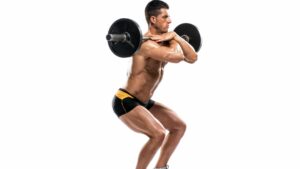Mastering Squats for Optimal Quad Development
1. Barbell Back Squats
Barbell back squats are the kingpin of quad-building exercises. They engage multiple muscle groups, with a primary focus on the quads, glutes, and hamstrings. This compound movement allows for heavier weights, stimulating significant muscle growth in the quads.

2. Front Squats
Front squats place greater emphasis on the quads by shifting the barbell’s placement to the front of your shoulders. This variation demands more upright posture, engaging the quads to a higher degree while also targeting the core.

3. Hack Squats
Hack squats are performed using a hack squat machine or a hack squat sled. This exercise minimizes stress on the lower back while isolating the quads. It involves a more controlled movement, enabling you to target the quads more directly.

4. Split Squats
This unilateral exercise hones in on each leg individually. By performing split squats, you enhance balance and stability while emphasizing the quadriceps. It also helps address muscle imbalances between the legs.

5. Overhead Squats
Overhead squats involve lifting a weight overhead while performing a squat. This full-body exercise not only challenges the quads but also engages the shoulders, core, and lower back, enhancing overall strength and stability.

The Importance of Proper Form
Regardless of the squat variation you choose, maintaining proper form is crucial for both safety and effectiveness. Here are some pointers:
Maintain a neutral spine: Avoid rounding or arching your back excessively.
Keep your knees aligned: Ensure they track over your toes without collapsing inward.
Control the descent and ascent: Avoid rushing through the movement; focus on controlled, steady motions.
Adjust weights gradually: Start with lighter weights to perfect your form before increasing the load.
So.
Incorporating these squat variations into your workout routine can significantly contribute to quad development. Remember, consistency and proper technique are key. Gradually increase the intensity and weight to continually challenge your muscles and stimulate growth.
By diversifying your squat repertoire and focusing on impeccable form, you’ll not only strengthen your quads but also enhance overall lower-body strength and stability.
Addressing Common Challenges in Squatting for Quad Development
While squats are phenomenal for quad growth, certain challenges might hinder your progress. Let’s tackle those and provide solutions to optimize your squat routine.
1. Limited Range of Motion (ROM)
Sometimes, a restricted ROM can limit quad engagement. To combat this, try box squats. By squatting onto a box or bench, you’ll ensure consistent depth, allowing you to focus on proper form and increasing quad activation.
2. Quad Dominance vs. Glute Activation
If you feel your quads overpowering your glutes, incorporate pause squats. Pausing at the bottom of the squat eliminates momentum and forces your muscles to work harder to initiate the movement, leading to better glute activation while still targeting the quads.
3. Inadequate Warm-Up
A proper warm-up is crucial for optimal performance and injury prevention. Dynamic stretches, bodyweight squats, and foam rolling can prepare your muscles and joints, enhancing your squatting performance and minimizing the risk of injury.
4. Not Enough Variation
Sticking to the same routine can lead to plateaus. Periodically switch up your squat variations to shock your muscles and prevent adaptation. Incorporate different rep ranges, tempos, and implements (like kettlebells or resistance bands) to challenge your quads in new ways.
5. Ignoring Mobility and Flexibility
Poor mobility can hinder squat depth and overall performance. Work on hip, ankle, and thoracic spine mobility through targeted exercises and stretches. Improved mobility allows for better squat mechanics and deeper positions, maximizing quad engagement.
Conclusion
The road to maximizing quad development through squats involves more than just performing the exercises. It requires attention to detail, consistency, and a willingness to adapt and overcome challenges.
By incorporating variations, addressing weaknesses, focusing on proper warm-up, and improving mobility, you can optimize your squat routine for enhanced quad development while minimizing the risk of injury and stagnation.
Remember, listen to your body, prioritize quality over quantity, and gradually progress to achieve those quad gains while maintaining a safe and effective workout regimen.
External Resources:
Box Squats: Benefits and How-To Guide – Stack
The Importance of a Proper Warm-Up for Squats – Healthline
Mobility Exercises for Better Squats – BOXROX
The Benefits of Squats for Building Leg Muscles – Muscle and Fitness
Front vs. Back Squats: Which Is Better for Quad Development? – Bodybuilding.com
Hack Squat Techniques and Variations – T-Nation
Comparison tabular
| Squat Variation | Primary Emphasis | Additional Muscles Engaged | Key Benefits |
|---|---|---|---|
| Barbell Back Squats | Quads, Glutes, Hamstrings | Lower back, Core | Allows heavier loads for overall leg strength |
| Front Squats | Quads | Core, Upper back | Greater quad emphasis with upright posture |
| Hack Squats | Quads | Glutes, Hamstrings | Minimizes stress on the lower back |
| Split Squats | Quads (unilateral) | Glutes, Hamstrings, Core | Addresses muscle imbalances between legs |
| Overhead Squats | Quads, Shoulders, Core | Lower back, Upper back, Full-body engagement | Enhances overall strength and stability |
Each squat variation comes with its unique benefits and muscle engagement. By incorporating a mix of these variations into your workout routine, you can effectively target your quads while engaging other muscle groups for overall lower-body strength and stability.
Remember, the best approach is to diversify your exercises, maintain proper form, gradually increase intensity, and listen to your body to achieve optimal quad development and overall fitness.
Wrapping up
Achieving optimal quad development through squats is a journey that requires dedication, consistency, and a strategic approach. By incorporating various squat variations, maintaining proper form, addressing challenges, and focusing on mobility and warm-up, you can maximize the growth of your quadriceps while enhancing overall lower-body strength and stability.
Remember, there’s no one-size-fits-all approach. Listen to your body, adjust your routine accordingly, and prioritize quality over quantity. Gradually progress, challenge yourself, and celebrate the incremental improvements along the way.
Ultimately, the key lies in a balanced approach diversify your exercises, pay attention to form and technique, and be patient with your progress. With dedication and perseverance, you’ll achieve the quad strength and development you desire while enjoying the myriad benefits of a well-rounded workout routine.
Happy squatting and here’s to strong, powerful quads and a healthier you.
If you ever need further guidance or have more questions about squats or fitness in general, don’t hesitate to reach out. Keep pushing towards your fitness goals!

Hey there, it’s Mike Rrsq, the Editor-in-Chief over at Jsquat.com, and I’m absolutely obsessed with all things squat fitness! I’ve been lucky enough to get some serious recognition for my work in this field. With a solid background in the fitness and wellness industry, I’ve been there right from the get-go, helping shape this website into what it is today.
You see, I’m not just the boss around here; I’m also a passionate contributor. I love sharing my insights through my articles, and trust me, they’re not your run-of-the-mill stuff. Each piece I write is a labor of love, filled with my expertise and real-world experience in the fitness universe. So, if you’re into fitness and looking for some inspiration, you’re in the right place!
Related Posts
- Why Your Leg Muscles Are Not Growing With Squat (Explained)
If you're someone who's been trying to build muscle in your legs but has been…
- Should squat jump make me feel a burn in my hip flexor muscles
Squats and jump squats can engage the hip flexor muscles, particularly if your form or…
- Improving Posture: Is the Back Squat the Right Choice
Posture plays a pivotal role in overall health and well-being. Many seek exercises to strengthen…
- Comparing Back Squat to Other Leg Exercises: A Comprehensive Analysis
When it comes to sculpting those powerful lower limbs, few exercises rival the iconic back…
- Front Squat and Rhomboid Muscles: Understanding the Connection
Front squats are a fantastic exercise, renowned for their ability to target various muscle groups,…
- Should depth jump squat makes me feel a burn in my oblique muscles
Depth jump squats can indeed engage your oblique muscles, although they might not be the…
- Should 18-year old female beginner do back squat before or after other exercises
Whether to do back squats before or after other exercises as an 18-year-old female beginner…
- Squat variations for 20-year-old female the target muscles and equipment needed
Squats are fantastic for overall lower body strength, and there's a range of variations perfect…
